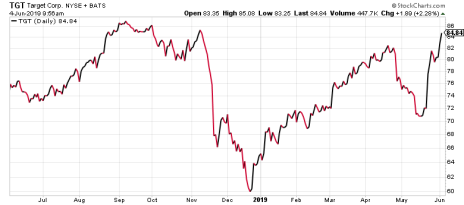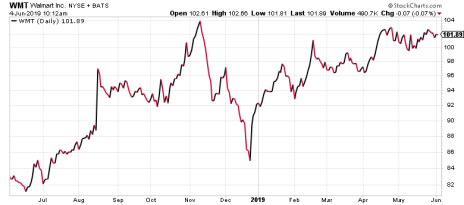May was a poor month for U.S. stocks. While most retail stocks suffered greatly, Target (TGT) and Walmart (WMT) exhibited bullish price charts. I’m not adding either Target stock or Walmart stock to my Cabot Undervalued Stocks Advisor portfolio just yet, because their fundamentals are not strong enough. However, these are the go-to stocks for institutional investors who want to assess the discount store landscape in search of potential portfolio stocks. Let’s review their outlooks in this breakdown of Target stock vs. Walmart stock.
Target Stock vs. Walmart Stock: Tale of the Tape
Target Corp. (TGT – yield 3.1%) reported first-quarter EPS and comparable store sales higher than expected, after which five investment firms promptly raised their price targets to a range of 80-100. Target is benefiting from the 2018 Toys R Us/Babies R Us bankruptcy and seems to be stealing market share from big department stores.
[text_ad]
Wall Street expects Target to grow EPS by 10.0% and 6.2% in fiscal 2020 and 2021 (January year end). The current P/E is 14.0, which is on the low end of its five-year range, indicating that the stock is somewhat undervalued. Watch for a small dividend increase to be announced during the first half of June. Both the earnings outlook and valuation appear much more attractive than Walmart’s numbers.
The price chart is relatively bullish, although the stock already had a recent run-up in May. There’s 5% upside as TGT retraces its September 2018 high at 87.
If I owned TGT stock, I’d keep it, then reassess as it reaches 87. I’m not thrilled with next year’s projected 6.2% EPS growth rate, but as long as that number remains more attractive than its discount retail peers, there will be a solid place for TGT within institutional equity portfolios.
Walmart (WMT – yield 2.1%) reported a good first quarter, including higher gross margins and lower expenses than analysts had expected. Like Target, Walmart is also benefiting from the 2018 Toys R Us/Babies R Us bankruptcy and seems to be stealing market share from big department stores.
Wall Street expects Walmart’s EPS to fall 1.6% in fiscal 2020, then to rise 4.6% in 2021 (January year end). The current P/E is 21.1. It’s hard to imagine any portfolio manager choosing Walmart over Target, based on the strong differences between their earnings growth rates and valuation.
Despite the lackluster fundamentals, the WMT price chart is bullish. The stock could soon surpass its January 2018 all-time high of 106.
If I owned WMT, I’d be psyched that the price chart is bullish, but cautious that the P/E seems to be floating unsupported in the stratosphere. I’d use a stop-loss order to protect my down side.
Bottom Line
Again, I’m not recommending either of these dominant retail players just yet. But if I had to pick one, Target stock is the clear winner, despite the strength in the WMT stock chart.
If you want to know which stocks I am currently recommending - and with the market pulling back the way it has for the past month-plus, there aren’t many at the moment - you can click here to learn how to become a Cabot Undervalued Stocks Advisor subscriber.
[author_ad]


